What is Esperanto Dictionary
According to security professionals, Esperanto Dictionary is a browser extension that acts as adware. Adware is form of software designed to display unwanted advertisements on a PC, redirect search results to advertising web-pages and gather sensitive info for marketing purposes. Esperanto Dictionary extension can show banner ads, full-screen advertisements, pop ups, videos, or other varieties of online advertising. It can attack your PC system’s web browsers such as the Chrome, IE, MS Edge and Firefox. Maybe you approve the idea that the ads or popups is just a small problem. But these intrusive ads eat computer resources and slow down your web-browser performance.

Unwanted ads
Another reason why you need to delete adware is its online data-tracking activity. Adware can have spyware and keyloggers built into the program, leading to greater damage to your PC and possible invasion of your personal information.
How does Esperanto Dictionary get on your PC
Adware gets onto computers by being attached to various free software. This means that you need to be very careful when installing applications downloaded from the Internet, even from a large proven hosting. Be sure to read the Terms of Use and the Software license, select only the Manual, Advanced or Custom installation type, switch off all unnecessary web browser extensions and software are offered to install.
Threat Summary
| Name | Esperanto Dictionary |
| Type | adware, potentially unwanted application (PUA), pop up virus, popups, popup ads |
| Symptoms |
|
| Removal | Esperanto Dictionary removal guide |
How to remove Esperanto Dictionary adware (removal steps)
In order to delete Esperanto Dictionary from the Edge, Internet Explorer, Google Chrome and Mozilla Firefox, you need to reset the internet browser settings. Additionally, you should look up for other dubious entries, such as files, programs, web-browser extensions and shortcuts. However, if you want to get rid of the adware software easily, you should run reputable antimalware utility and let it do the job for you.
To remove Esperanto Dictionary, use the steps below:
- Manual Esperanto Dictionary removal
- Automatic Removal of Esperanto Dictionary
- How to stay safe online
Manual Esperanto Dictionary removal
This part of the post is a step-by-step instructions that will help you to remove adware software manually. You just need to carefully complete each step. In this case, you do not need to install any additional utilities.
Remove adware software through the MS Windows Control Panel
You can manually remove most nonaggressive adware by uninstalling the program that it came with or removing the adware software itself using ‘Add/Remove programs’ or ‘Uninstall a program’ option in Windows Control Panel.
- If you are using Windows 8, 8.1 or 10 then press Windows button, next click Search. Type “Control panel”and press Enter.
- If you are using Windows XP, Vista, 7, then click “Start” button and press “Control Panel”.
- It will show the Windows Control Panel.
- Further, click “Uninstall a program” under Programs category.
- It will show a list of all apps installed on the computer.
- Scroll through the all list, and remove questionable and unknown applications. To quickly find the latest installed software, we recommend sort apps by date.
See more details in the video guide below.
Remove Esperanto Dictionary adware from IE
The Internet Explorer reset is great if your browser is hijacked or you have unwanted add-ons or toolbars on your browser, that installed by an malicious software.
First, run the Microsoft Internet Explorer, then click ‘gear’ icon ![]() . It will display the Tools drop-down menu on the right part of the web-browser, then press the “Internet Options” as displayed on the screen below.
. It will display the Tools drop-down menu on the right part of the web-browser, then press the “Internet Options” as displayed on the screen below.

In the “Internet Options” screen, select the “Advanced” tab, then click the “Reset” button. The Microsoft Internet Explorer will display the “Reset Internet Explorer settings” dialog box. Further, click the “Delete personal settings” check box to select it. Next, click the “Reset” button as on the image below.

After the process is finished, click “Close” button. Close the Internet Explorer and restart your computer for the changes to take effect. This step will help you to restore your web-browser’s default search provider, homepage and newtab page to default state.
Delete Esperanto Dictionary from Mozilla Firefox
If your Firefox browser is hijacked by Esperanto Dictionary or an unknown search engine opens results for your search, then it may be time to perform the internet browser reset. It will keep your personal information like browsing history, bookmarks, passwords and web form auto-fill data.
Start the Mozilla Firefox and click the menu button (it looks like three stacked lines) at the top right of the web browser screen. Next, press the question-mark icon at the bottom of the drop-down menu. It will open the slide-out menu.

Select the “Troubleshooting information”. If you are unable to access the Help menu, then type “about:support” in your address bar and press Enter. It bring up the “Troubleshooting Information” page as displayed on the image below.

Click the “Refresh Firefox” button at the top right of the Troubleshooting Information page. Select “Refresh Firefox” in the confirmation prompt. The Mozilla Firefox will start a procedure to fix your problems that caused by the Esperanto Dictionary adware. After, it is complete, press the “Finish” button.
Remove Esperanto Dictionary from Chrome
Reset Google Chrome settings will remove Esperanto Dictionary from browser and disable malicious addons. It will also clear cached and temporary data (cookies, site data and content). However, your saved bookmarks and passwords will not be lost. This will not affect your history, passwords, bookmarks, and other saved data.

- First start the Chrome and click Menu button (small button in the form of three dots).
- It will open the Google Chrome main menu. Choose More Tools, then click Extensions.
- You will see the list of installed addons. If the list has the add-on labeled with “Installed by enterprise policy” or “Installed by your administrator”, then complete the following steps: Remove Chrome extensions installed by enterprise policy.
- Now open the Chrome menu once again, press the “Settings” menu.
- You will see the Google Chrome’s settings page. Scroll down and press “Advanced” link.
- Scroll down again and click the “Reset” button.
- The Google Chrome will display the reset profile settings page as on the image above.
- Next click the “Reset” button.
- Once this procedure is complete, your web-browser’s new tab page, search engine and startpage will be restored to their original defaults.
- To learn more, read the article How to reset Google Chrome settings to default.
Automatic Removal of Esperanto Dictionary
Malware removal tools are pretty useful when you think your computer is infected by adware. Below we will discover best utilities that can remove adware software from your computer and browser.
Use Zemana to remove Esperanto Dictionary adware
Zemana AntiMalware is a malware removal utility created for Windows. This utility will help you delete adware software, various types of malware (including hijackers and PUPs) from your personal computer. It has simple and user friendly interface. While the Zemana does its job, your computer will run smoothly.

- Installing the Zemana Free is simple. First you’ll need to download Zemana by clicking on the link below.
Zemana AntiMalware
164814 downloads
Author: Zemana Ltd
Category: Security tools
Update: July 16, 2019
- At the download page, click on the Download button. Your web browser will show the “Save as” dialog box. Please save it onto your Windows desktop.
- Once downloading is done, please close all programs and open windows on your PC system. Next, start a file called Zemana.AntiMalware.Setup.
- This will launch the “Setup wizard” of Zemana AntiMalware (ZAM) onto your device. Follow the prompts and do not make any changes to default settings.
- When the Setup wizard has finished installing, the Zemana Anti Malware (ZAM) will start and show the main window.
- Further, click the “Scan” button for scanning your PC system for the Esperanto Dictionary adware. Depending on your computer, the scan may take anywhere from a few minutes to close to an hour. While the tool is scanning, you can see how many objects and files has already scanned.
- After the system scan is finished, Zemana AntiMalware will show you the results.
- Review the results once the tool has complete the system scan. If you think an entry should not be quarantined, then uncheck it. Otherwise, simply press the “Next” button. The utility will remove Esperanto Dictionary adware and move the selected threats to the program’s quarantine. Once the procedure is finished, you may be prompted to restart the computer.
- Close the Zemana AntiMalware and continue with the next step.
Get rid of Esperanto Dictionary adware software and malicious extensions with HitmanPro
HitmanPro is a free program which developed to delete malicious software, potentially unwanted applications, browser hijackers and adware from your personal computer running Microsoft Windows 10, 8, 7, XP (32-bit and 64-bit). It’ll help to find and remove Esperanto Dictionary adware, including its files, folders and registry keys.
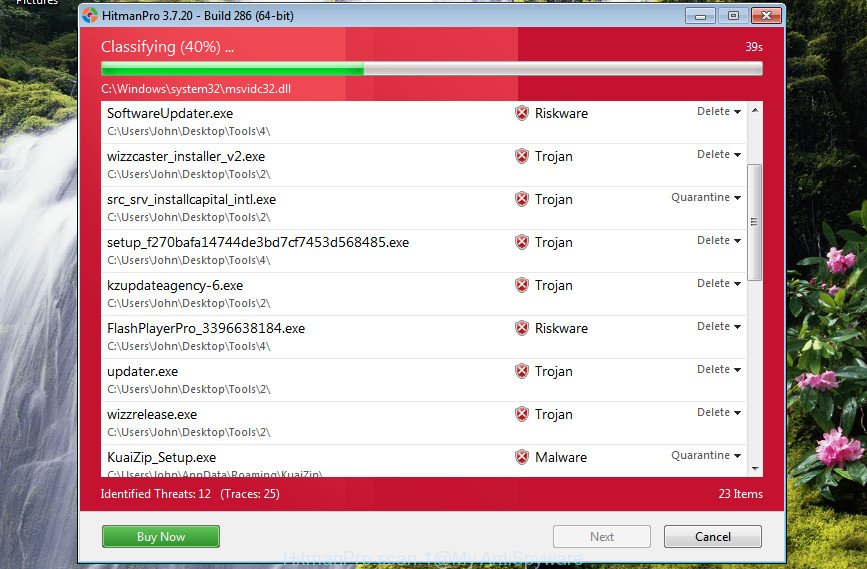
- First, visit the following page, then click the ‘Download’ button in order to download the latest version of HitmanPro.
- After the downloading process is finished, double click the Hitman Pro icon. Once this tool is launched, press “Next” button to look for Esperanto Dictionary . Depending on your computer, the scan can take anywhere from a few minutes to close to an hour. While the Hitman Pro is checking, you can see how many objects it has identified either as being malicious software.
- After the checking is done, it will show the Scan Results. Review the report and then click “Next” button. Now click the “Activate free license” button to start the free 30 days trial to remove all malicious software found.
How to remove Esperanto Dictionary with MalwareBytes AntiMalware (MBAM)
We advise using the MalwareBytes Anti Malware. You may download and install MalwareBytes Free to search for adware and get rid of unwanted ads from your web-browsers. When installed and updated, this free malware remover automatically detects and deletes all threats exist on the device.
Visit the following page to download the latest version of MalwareBytes AntiMalware (MBAM) for Windows. Save it on your Windows desktop.
327071 downloads
Author: Malwarebytes
Category: Security tools
Update: April 15, 2020
After the downloading process is finished, close all windows on your device. Further, launch the file named MBSetup. If the “User Account Control” dialog box pops up as displayed below, click the “Yes” button.
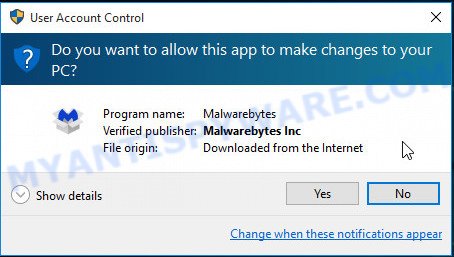
It will display the Setup wizard that will assist you set up MalwareBytes on the personal computer. Follow the prompts and do not make any changes to default settings.
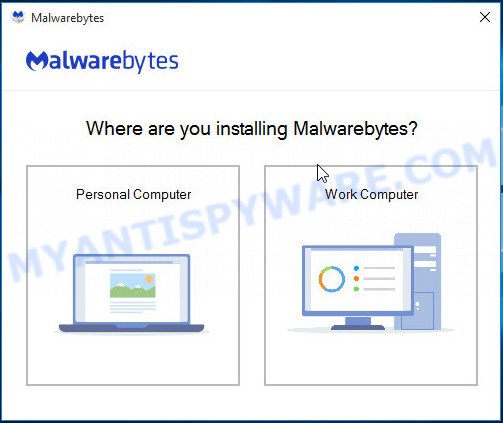
Once installation is done successfully, click “Get Started” button. Then MalwareBytes will automatically start and you may see its main window as shown in the following example.
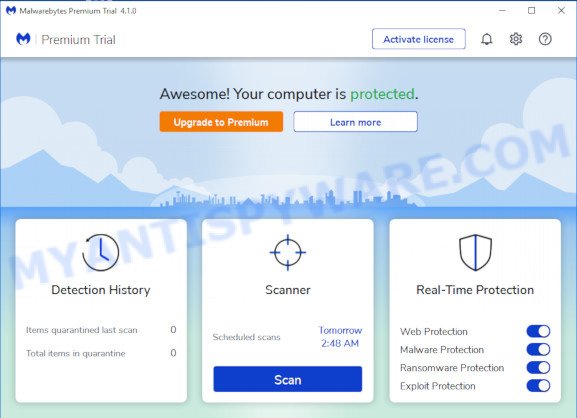
Next, click the “Scan” button to perform a system scan with this utility for the Esperanto Dictionary adware. This procedure can take quite a while, so please be patient.
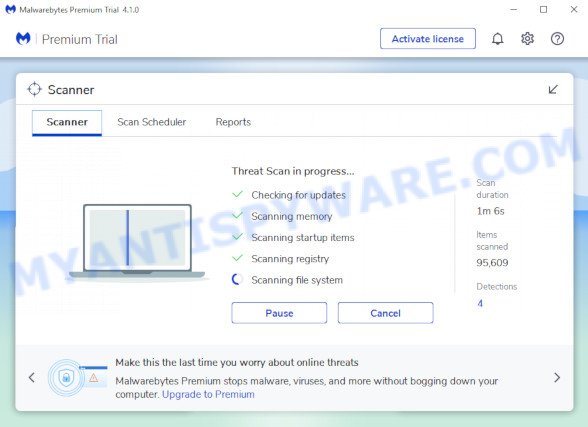
When the checking is finished, MalwareBytes will prepare a list of unwanted apps and adware software. Next, you need to click “Quarantine” button.
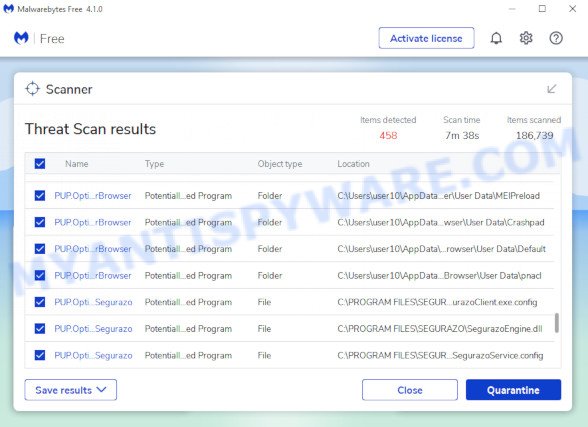
The MalwareBytes will remove adware software and move the selected items to the Quarantine. After finished, you can be prompted to reboot your PC system. We suggest you look at the following video, which completely explains the process of using the MalwareBytes to remove browser hijackers, adware and other malware.
How to stay safe online
Use ad-blocker application such as AdGuard in order to stop ads, malvertisements, pop-ups and online trackers, avoid having to install harmful and adware browser plug-ins and add-ons that affect your computer performance and impact your PC security. Surf the Internet anonymously and stay safe online!
- Visit the page linked below to download the latest version of AdGuard for Windows. Save it directly to your Microsoft Windows Desktop.
Adguard download
26843 downloads
Version: 6.4
Author: © Adguard
Category: Security tools
Update: November 15, 2018
- After the download is done, run the downloaded file. You will see the “Setup Wizard” program window. Follow the prompts.
- Once the setup is done, press “Skip” to close the setup program and use the default settings, or press “Get Started” to see an quick tutorial which will assist you get to know AdGuard better.
- In most cases, the default settings are enough and you don’t need to change anything. Each time, when you run your PC, AdGuard will launch automatically and stop unwanted ads, block Esperanto Dictionary redirects, as well as other harmful or misleading websites. For an overview of all the features of the program, or to change its settings you can simply double-click on the icon named AdGuard, that can be found on your desktop.
To sum up
We suggest that you keep AdGuard (to help you block unwanted pop up ads and unwanted malicious websites) and Zemana Anti Malware (ZAM) (to periodically scan your PC system for new adware softwares and other malware). Probably you are running an older version of Java or Adobe Flash Player. This can be a security risk, so download and install the latest version right now.
If you are still having problems while trying to delete Esperanto Dictionary from the Internet Explorer, Edge, Firefox and Chrome, then ask for help here here.


















